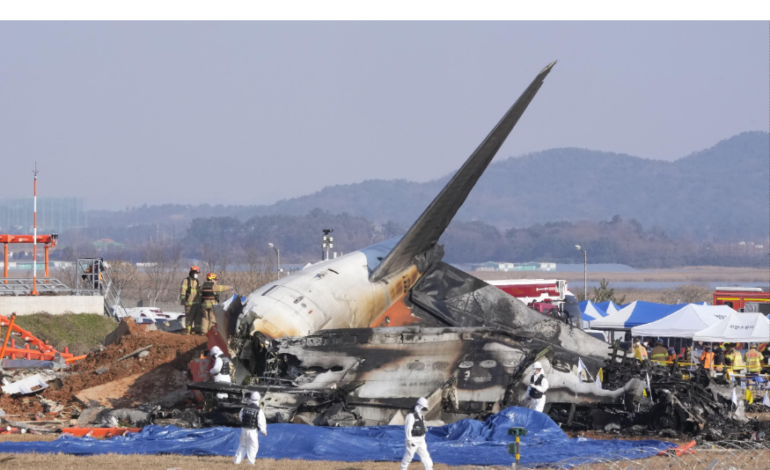
Seven plane crashes in a month – Policy failure or political agenda?
By: Dr Avi Verma
Since President Donald Trump’s inauguration on January 20, 2025, the United States has recorded seven plane crashes, raising serious concerns about aviation safety and regulatory oversight. These incidents, including the midair collision near Washington, D.C., the tragic medical transport crash in Philadelphia, and the Delta Airlines crash in Toronto, have left the nation questioning whether these are unfortunate coincidences or the result of deeper systemic failures.
The alarming spike in plane crashes
The seven crashes recorded within a month of Trump’s presidency have resulted in multiple fatalities and near-catastrophic incidents:
- January 29, 2025: A midair collision between an American Airlines regional jet and a U.S. Army Black Hawk helicopter in Washington, D.C., killed all passengers aboard both aircraft. This was the deadliest crash since 2001.
- January 31, 2025: A medical transport jet carrying a child patient, her mother, and four others crashed into a Philadelphia neighborhood, causing an explosion that engulfed several homes.
- February 5, 2025: A Cessna Grand Caravan crashed in Alaska, killing 10 people after losing radar contact en route from Unalakleet to Nome.
- February 10, 2025: A Learjet veered off the runway in Scottsdale, Arizona, colliding with a Gulfstream 2100 business jet. One person died on impact.
- February 12, 2025: A two-seat EA-18 Growler crashed into the waters near San Diego. The pilots were rescued after being in the ocean for over a minute.
- February 16, 2025: A small plane crashed shortly after takeoff from a municipal airport in Georgia, killing two people.
- February 17, 2025: A Delta Airlines jet crashed while attempting to land at Toronto Pearson Airport amid extreme weather. The plane flipped over on the tarmac, though all 80 passengers survived.
While aviation incidents are not uncommon, the rate at which these crashes have occurred in just one month is concerning. The question remains: is this a coincidence, a result of deregulation, or an issue that began under the previous administration?
Trump’s response: Firing FAA employees and scrapping DEI programs
In a controversial move, the Trump administration has begun firing hundreds of FAA employees, including probationary workers and technical staff responsible for radar, landing, and navigational aid maintenance. The mass terminations came just weeks after the Washington, D.C., collision, adding uncertainty to an already fragile aviation system.
Trump has also placed blame on Diversity, Equity, and Inclusion (DEI) policies, claiming they have compromised the quality of air traffic controllers and aviation personnel. His executive order eliminating DEI programs across federal agencies, including the FAA, has been framed as a move to “restore faith” in air travel.
However, experts argue that eliminating DEI programs does not address the actual issues plaguing aviation safety. Reports suggest that many FAA employees let go were not involved in DEI hiring but were essential to radar and navigation maintenance. The Professional Aviation Safety Specialists (PASS) union has warned that these firings could significantly impact air safety operations in the coming months.
Biden’s role: A legacy of lax oversight?
While Trump has taken drastic action, some argue that the root of these problems can be traced back to the Biden administration. Data from the National Transportation Safety Board (NTSB) suggests that the first four weeks of Biden’s presidency saw nearly double the number of fatal plane crashes compared to the same period under Trump’s second term.
Between January 20, 2021, and February 18, 2021, there were 10 fatal plane crashes in the U.S., resulting in 18 deaths. Critics point to former Transportation Secretary Pete Buttigieg’s tenure, which they claim was marked by weak regulatory enforcement, failure to address pilot shortages, and outdated safety measures at the FAA.
Biden-era policies prioritized hiring more diverse air traffic controllers, pilots, and aviation safety officials, an initiative Trump has called dangerous. However, aviation experts have noted that while increasing diversity in the workforce is important, it should not come at the cost of lowering qualifications or reducing training requirements.
Aviation safety data: Are crashes on the rise?
A look at publicly available FAA and NTSB data provides a broader context:
- In 2023, there were 29 fatal plane crashes in the U.S.
- In 2022, there were 31 fatal crashes recorded.
- In 2021, under Biden’s first year, the number spiked to 36 fatal crashes.
- By comparison, Trump’s first year in 2017 saw 29 fatal crashes, but the numbers steadily declined during his presidency, reaching 27 crashes in 2020.
The recent spike in 2025 suggests an alarming trend. However, aviation safety experts caution that a single month of incidents cannot determine an administration’s full impact on aviation policy.
Who is responsible?
Is the recent string of crashes a direct result of Trump’s abrupt policy shifts, including mass firings at the FAA? Or is it a consequence of years of regulatory neglect under Biden?
Perhaps the real failure lies in the politicization of aviation safety itself. Instead of engaging in partisan blame games, leaders must prioritize tangible solutions—investing in air traffic control technology, ensuring rigorous hiring and training standards, and maintaining a fully staffed, experienced FAA workforce.
The American public deserves an aviation system where safety is paramount—not one where passengers become casualties of political agendas.